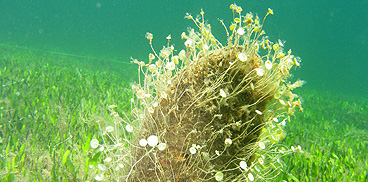A-BISSO

With scientific support from the Centre of Expertise in Marine Biodiversity (Com.Bio.Ma), Conservatoria delle Coste started A-bisso project on the management and stewardship of Pinna nobilis in an area in South-East Sardinia.
Pinna nobilis, commonly known as “noble pen shell”, can reach and exceed lengths of 100 cm in some Mediterranean areas. It lives up to 40 years, attaching itself to substrate using its byssus, a set of long filaments (up to 20 cm) that begin as a liquid secreted from the byssal gland, located close to the foot. The noble pin shell is considered to be one of the largest bi-valve molluscs in the world (Vicente et al., 1980).
The two-year A-bisso project was conducted in a sea area between Calasetta, Carloforte, Portoscuso and Sant'Antioco. This area has some of the largest populations of Pinna nobilis in the Mediterranean, both in terms of density and specimen size, some of which can exceed 120 cm in height.
This area, and in particular Sant’Antioco, is characterised by a strong tradition of byssus weaving – the thread is very valuable and is commonly called “silk of the sea”. The traditional working technique has been carried forward by the unique world famous byssus weaver, Chiara Vigo.
With the A-bisso project, Conservatoria delle Coste intends to dedicate particular attention to an area of notable environmental interest. The main objective of the project is to assess the presence of Pinna nobilus and to study an effective management system for the resource.
Pinna nobilis, commonly known as “noble pen shell”, can reach and exceed lengths of 100 cm in some Mediterranean areas. It lives up to 40 years, attaching itself to substrate using its byssus, a set of long filaments (up to 20 cm) that begin as a liquid secreted from the byssal gland, located close to the foot. The noble pin shell is considered to be one of the largest bi-valve molluscs in the world (Vicente et al., 1980).
The two-year A-bisso project was conducted in a sea area between Calasetta, Carloforte, Portoscuso and Sant'Antioco. This area has some of the largest populations of Pinna nobilis in the Mediterranean, both in terms of density and specimen size, some of which can exceed 120 cm in height.
This area, and in particular Sant’Antioco, is characterised by a strong tradition of byssus weaving – the thread is very valuable and is commonly called “silk of the sea”. The traditional working technique has been carried forward by the unique world famous byssus weaver, Chiara Vigo.
With the A-bisso project, Conservatoria delle Coste intends to dedicate particular attention to an area of notable environmental interest. The main objective of the project is to assess the presence of Pinna nobilus and to study an effective management system for the resource.
